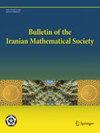A Remark on a Result of Huber and Kahn
IF 0.8
4区 数学
Q2 MATHEMATICS
引用次数: 0
Abstract
A. Huber and B. Kahn construct a relative slice filtration on the motive M(X) associated to a principal T-bundle \(X\rightarrow Y\) for a smooth scheme Y. As a consequence of their result, one can observe that the mixed Tateness of the motive M(Y) implies that the motive M(X) is mixed Tate. In this note we prove the inverse implication for a principal G-bundle, for a split reductive group G.
关于胡贝尔和卡恩一个结果的评论
A.胡贝尔(A. Huber)和卡恩(B. Kahn)在与光滑方案 Y 的主 T 束相关联的动机 M(X) 上构造了一个相对切片过滤。作为他们的结果,我们可以观察到动机 M(Y) 的混合塔特性意味着动机 M(X) 是混合塔特的。在本注中,我们将证明主 G 束的反向蕴涵,即分裂还原群 G 的反向蕴涵。
本文章由计算机程序翻译,如有差异,请以英文原文为准。
求助全文
约1分钟内获得全文
求助全文
来源期刊

Bulletin of The Iranian Mathematical Society
Mathematics-General Mathematics
CiteScore
1.40
自引率
0.00%
发文量
64
期刊介绍:
The Bulletin of the Iranian Mathematical Society (BIMS) publishes original research papers as well as survey articles on a variety of hot topics from distinguished mathematicians. Research papers presented comprise of innovative contributions while expository survey articles feature important results that appeal to a broad audience. Articles are expected to address active research topics and are required to cite existing (including recent) relevant literature appropriately. Papers are critically reviewed on the basis of quality in its exposition, brevity, potential applications, motivation, value and originality of the results. The BIMS takes a high standard policy against any type plagiarism. The editorial board is devoted to solicit expert referees for a fast and unbiased review process.
 求助内容:
求助内容: 应助结果提醒方式:
应助结果提醒方式:


